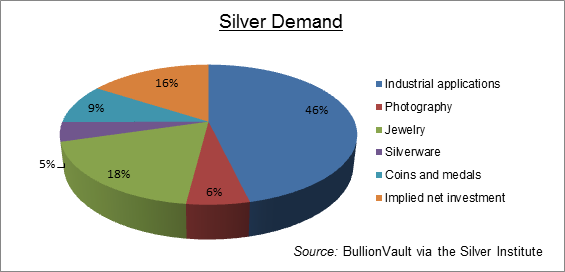For all of its monetary and investment history, silver is by far an industrial metal today. The industrial sector consumed close to 466 million ounces of silver in 2012 according to the Silver Institute. Add what’s left of photographic demand, and you get to 524 million ounces, some 52% of total production (1,048.3 million ounces in 2012).
We already discussed what happened to photographic demand in Part 1 and we looked at photovoltaic (PV) silver consumption in Part 2 of this series. There we saw how PV demand remains a long way from filling the gap left by the collapse of photography.

So who does buy silver in bulk? Well, silver is also used in electronics and catalysts. And a fast-growing industry that consumes silver is the production of ethylene oxide.
Ethylene oxide (EO) is used in the production of antifreeze, polyester, heat transfer liquids, gas dehydration, and solvents. It is also used in cosmetics, pharmaceuticals, lubricants, paint solvents, soaps, detergents, gas purification, emulsifiers and dispersants. Because of the wonderful properties of this reactive chemical, its growth has benefited the silver market as well. Because the precious metal is used as a catalyst in EO production.
Some 90% of silver’s total catalyst demand comes from EO production. The EO market has enjoyed a 30-year continued growth cycle, according to consultancy Metals Focus Ltd. In 2002 it consumed 100 million ounces of silver, and it is projected by 2017 to reach 225 million ounces per annum. This rivals the historical high of the photographic industry. However, the EO market will not continue to grow at this pace. Because consumers are able to recover the silver from the catalyst. This means that at some point its demand will stabilize and perhaps decrease.
By geographical area, the United States is the largest consumer of silver. It is also the largest consumer of silver jewelry. Over the last couple of years demand to buy silver as jewelry has remained strong, as gold remained at high prices, leading consumers to substitute. But now, with the recent decline in the gold price, there’s good reason to think silver will have a bigger struggle to keep its share of the market.What of that other major consumer of silver – investment? This is not a primary user. We are talking about the investor, who can substitute at will. As of this writing, the SLV (which is the call sign for the largest exchange-traded silver trust fund or ETF) is holding 320 million ounces of silver. This number represents 31% of annual world silver supply using 2012’s statistics.
That’s a significant overhang if it comes back to the market. But overall silver investment has grown significantly in both the ETF market and coins and medals. Since 2002 sales of coins and medals grew close to 250% worldwide. Yes, that only represents only half of the type of consumption we see for jewelry. But adding the ETF and other physical investment products together, it becomes larger than the jewelry by 28%.
What are the concerns then for an investor? What happens if the silver comes back into the market that is in the hands of investors? What happens if the price goes down? Finally what happens if the price goes up?
The funny thing with silver is that when the price goes down demand from the industrial sector and jewelry sector will rise and it will be consumed. It may take some time but it will happen. At the same time if the price is low then there will be less mining because of profitability. Eventually the fundamentals will drive the price higher.
If the price makes new highs we usually see large liquidations of metal either from scrap recovery or investors. This will force market prices to correct to a level that will sustain the available material. Of course if silver were to be demanded as forms of currency, then all bets are off. The price of silver would then reach unknown heights.
Fundamentally silver remains an indispensable metal. It is one that mankind cannot do without. There will always be uses and demand for silver. Its beauty and its relevance as a store of value – added along with its physical and chemical properties – make it an important part of anyone’s portfolio. Just like gold, it remains a good thing to own.
Miguel Perez-Santalla, Guest Contributor to MiningFeeds.com
About the author: Miguel Perez-Santalla is vice president of business development for BullionVault, the physical gold and silver exchange founded a decade ago and now the world’s #1 provider of physical bullion ownership online.



 Follow us on Twitter
Follow us on Twitter Become our facebook fan
Become our facebook fan











Comments are closed.